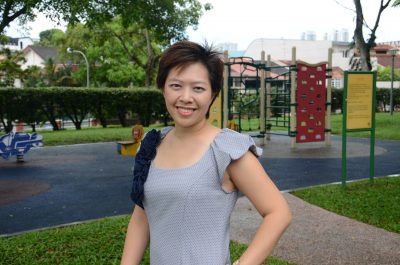Why Singapore’s English Teachers Should Embrace Singlish, Not Fight It
Is it time for Singaporean educators to embrace Singlish as a legitimate learning tool? What the Research […]
Read More
Positive education and parenting advocate Sha-En Yeo is the first person in Singapore to be awarded the prestigious Masters in Applied Positive Psychology (MAPP) degree from the University of Pennsylvania in the States. Always on the move to champion positive education in Singapore, she often ponders on how we can help our young children to thrive and not just survive in life. She shares with us her insights on this and how parenting can be made positive.

Sha-En Yeo advocates the three steps approach to positive parenting to encourage young children to thrive, and not just survive, in life.
A former teacher, Sha-En used to observe that students who excel academically tend to lack the necessary skills needed to handle their emotions and often struggle in managing their feelings.
“These students were academically brilliant but they often did not have the abilities to deal with failure,” she shares. “On the socio-emotional and psychological front, I felt that they didn’t have the skills to manage emotions well.” Wondering how she could help her students, Sha-En came across Martin Seligman’s book Learned Optimism. She began applying the strategies (promoting well-being) that she picked out from the book.
“If (well-being) alone can produce such an effect, what will more knowledge of similar concepts of well-being help to achieve?”
– Sha-En Yeo, a strong believer in positive education
“What I found next was that my students’ behaviours started to change,” she adds. Sha-En observed that they started believing in themselves and picking themselves back up when they experienced setbacks. These positive outcomes moved Sha-En to do more. “If a single concept alone can produce such an effect, what will more knowledge of similar concepts of well-being help to achieve?”
Further research into such concepts coupled with a stint in Guidance Branch (MOE) led Sha-En to discover a new domain in psychology called positive psychology. This prompted her to further her studies and focus on how to support students to cultivate the necessary psychosocial skills to help them thrive. As a parent herself, Sha-En also actively put these skills to use in her own home to raise thriving kids.
“As parents, we are our children’s role model, as cliché as that sounds, but what does being a role model actually mean?” Sha-En says. To her, it means practicing what she preaches to her children. “If we want them to do something, we have to try doing it ourselves too.”
At home, Sha-En often reminds herself to be mindful of her actions and words used because children tend to be natural observers and can easily notice any form of inconsistencies between what was preached and what was actually done. “It is not that we have to be perfect parents. We just need to be more reflective of our actions,” she adds.
One can thus consider positive parenting as a way of life rather than a set of methods or rules that is set in place to ensure discipline. One benefit of such parenting style includes the healthy development of the child because of positive relationship with the parents.
“It is not that we have to be perfect parents. We just need to be more reflective of our actions.”
– Sha-En, on the importance of reflection
“There are many ways to look at parenting. For me, I look at it as a three-pronged approach,” Sha-En shares. The three prongs of parenting comprises the self, environment and tools.
Self refers to the parents’ willingness to understand their children’s needs, and then cultivate their own disposition and skills to support them to thrive. This means spending time to reflect on their parenting journey and taking positive action.
“It is important for the parents to first know what they want for their children,” Sha-En explains. “It is also most parents’ goal for their children to achieve happiness and success in life, and be a good person.” Parents should thus also ask themselves: What can I do as a parent to support my children achieve those goals?
Environment refers to the child’s surroundings and settings. As such, it is crucial for parents to create a positive environment for children. An environment that encourages growth instead of one that focuses on the negatives allows the child to be better problem-solvers, feel good about themselves and be more creative. (Read A Positive Environment for Growth to find out how to nurture positivity at home.)
Tools refers to the set of strategies parents can use when interacting with their children that will empower them to thrive. An example is being able to encourage their children when they face a challenge. Very often, the child may feel like giving up; thus, the parents’ role to help them to persevere is crucial.
For instance, getting the child to switch to a different activity when they face difficulties with the first one might send them the message that it is okay to give up when the going gets tough. This message is likely be replayed in their life at a later stage. A better way is to work together with them in overcoming the challenges in the first activity. “We can let our children take a break first and then come back to try another way to solve it,” Sha-En explains.
By applying these concepts of positive education, Sha-En envisages confident children who do not measure themselves against a yardstick of academic results but rather, by whatever they may accomplish with their own effort; they will become children who not just live life, but thrive in life.